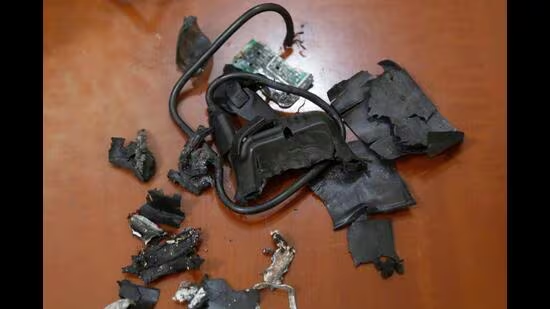Pager bombs: The theories and the science behind them
New Delhi: It is a question everyone is asking: How could it have been possible for anyone to trigger explosions in thousands of pagers simultaneously? Reports on Tuesday’s pager blasts across Lebanon, which killed at least 12 and injured nearly 3,000, have been varied in content but consistent in suggesting an orchestrated attack by Israel rather than a coincidence.

So, how could it have been done? By several accounts, the pagers had been tinkered with before they reached their users. Months before Tuesday’s detonations, Hezbollah had ordered 5,000 pagers from a Taiwan-based company, which has since issued a statement that the pagers were manufactured by another company based in Hungary using the Taiwanese company’s brand name.
Reports say the explosive material was hidden within these pagers before they were imported to Lebanon. Sky News Arabia named the explosive as PETN, short for pentaerythritol tetranitrate, well-known as a material of choice for military, civil and terrorist operations.
That leaves the question of how the explosions could have been triggered simultaneously. Sky News Arabia cited sources as saying that the PETN was detonated by remotely raising the batteries’ temperature, but scientists contacted by HT mentioned other possible ways, such as sending a simultaneous message to detonate the explosive.
Why use PETN
PETN, first synthesised in 1894 and extensively used during World War II, was most notoriously used in the Lockerbie bombing of 1988. The explosive was Semtex, a mixture of PETN and other chemicals. Placed in the cargo hold of a Pan Am flight from Frankfurt to Detroit, the explosive went off on December 21, 1988, causing the Boeing to disintegrate over Lockerbie in Scotland, killing all 259 on board and 11 on the ground.
The reason PETN is often mixed with other explosives is that it is a “secondary explosive”, just like RDX or TNT. “It means they have high energy density, so even a few grams will cause much destruction through explosion. However, they are relatively stable and hence need primary explosives such as lead azide (which is called a primer or a booster) to start the detonation of the secondary explosive,” said Prasenjit Maity, professor of chemistry and nanotechnology at the National Forensic Sciences University (NFSU) and currently director of NFSU’s Guwahati campus.
“In conventional and commercial explosive devices used for military, civil or mining projects, secondary explosives are mostly used as a mixture for better explosive strength, stability, and oxygen balance . The oxygen required for combustion is taken from their internal structure, not from the atmosphere. So, oxygen balance is very important in explosives chemistry,” Maity said.
Among the many reasons PETN is preferred for terrorist attacks, one is that X-rays cannot detect it directly, although it can be given away by the wiring and other electrical equipment that go into making the bomb. Again, because it packs so much power, it is often enough to carry small amounts of PETN.
Further, PETN is less stable than TNT and RDX, while their explosive strengths are comparable to one another. “PETN can be detonated with a very small electrical spark. If the information about PETN being used is correct, I believe they did not use pure PETN, rather they would have mixed it with some additives to make a plastic explosive (a soft clay-like appearance for easily fitting into any space or shape),” Maity said.
The possible trigger
If reports in the international media, which cite sources in the Lebanese establishment and Hezbollah, are taken at face value, then it is scientifically feasible that the pagers could have been converted into explosive devices at some stage of the delivery process. As of now, however, there is less clarity on how the devices were detonated together.
A telecommunications engineer, who asked not to be named, was not convinced by reports about the temperature of the batteries being raised remotely. He said it would have been easier to send a message simultaneously to devices programmed previously to detonate the explosive when this message arrived.
Maity, meanwhile, guessed at possible ways in which the explosives could have been detonated. “Of course, it was controlled remotely, either through some command that created an electric pulse inside the pagers that detonated the PETN-based plastic explosive, or through a specific command that heated the batteries to around 150°C, leading to detonation of the attached explosive charge,” he said.
Disclaimer: The copyright of this article belongs to the original author. Reposting this article is solely for the purpose of information dissemination and does not constitute any investment advice. If there is any infringement, please contact us immediately. We will make corrections or deletions as necessary. Thank you.
Title:Pager bombs: The theories and the science behind them
Url:https://www.investsfocus.com









